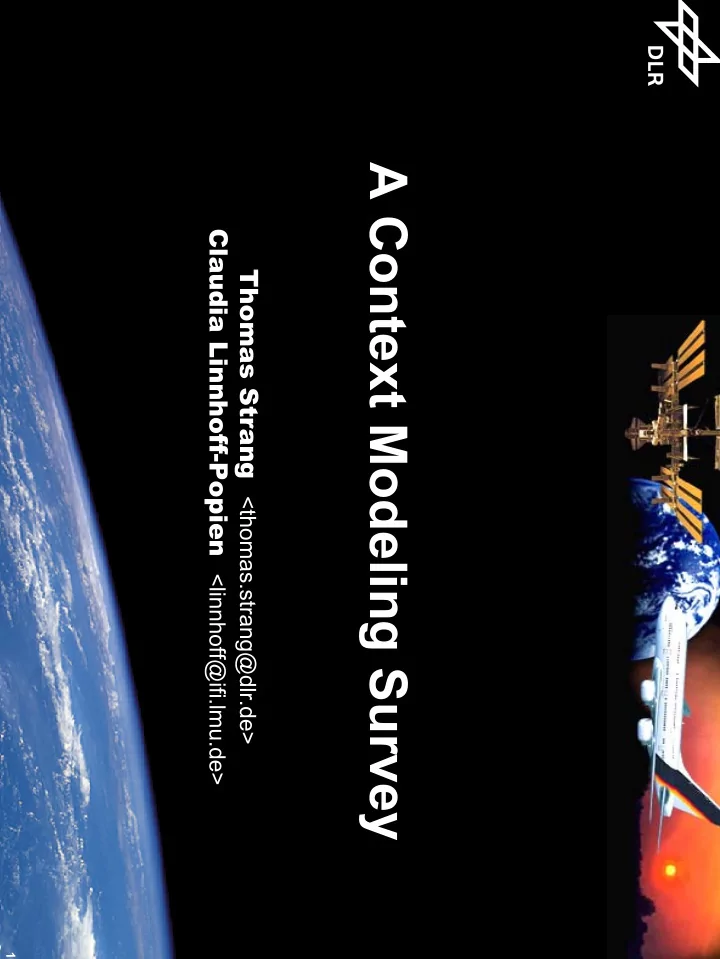

A Context Modeling Survey Claudia Linnhoff-Popien <linnhoff@ifi.lmu.de> Thomas Strang <thomas.strang@dlr.de> 1 1
UbiComp Evolution Chain Distributed Mobile Ubiquitous Computing Computing Computing Mobile Networks Context-Awareness Mobile Information Access Ad-hoc Networks Adaptive Applications Smart Sensors & Devices � Two main benefits from Context-Awareness for Mobile Services: Adaptation to changes in environment without user interaction � Context Effective information filter (typical mobile devices have limited UI!) � � Location-Awareness is special kind of Context-Awareness. � Typical Context Modeling & Integration Requirements for UbiComp: • high level of formality • incompleteness • distributed composition • quality of information • applicability to existing service frameworks • partial validation 2 2
Context Modeling Approaches (1/3) � Key-Value-Pairs Models � most simple category of models � not very efficient for more sophisticated structuring purposes � exact matching, no inheritance Environment Variables: Key-Value-Pairs � Markup Scheme Models � scheme implements model � typical representatives: profiles � Examples: Extensions of � • Composite Capabilities/Preference Profile (CC/PP) • User Agent Profile (UAProf) Comprehensive Structured Context Profiles (CSCP) � Pervasive Profile Description Language (PPDL) � Centaurus Capability Markup Language (CCML) � CSCP Instance based on RDF 3
Context Modeling Approaches (2/3) ORM Entity Type ORM Entity Type n-ary ORM Fact Type � Graphical Models permitted to use fact type profiled Person Device (name) (id) � particularly useful for structuring, but usually not used on instance level located at fact type sensed Person Location � Examples: (name) (name) M Well known: UML � engaged in Contextual Extended ORM � Activity (name) dependency [ ] Person fact (name) � Logic Based Models Location (name) M � Logic defines conditions on which a located at concluding expression or fact may be Contextual Extended ORM derived from a set of other expressions or facts (reasoning) � context is defined as facts, expressions and rules � High degree of formality � Examples: McCarthy’s Formalizing Context Context Expression from Extended Situation Theory � Akman&Surav’s Extended Situation Theory � 4
Context Modeling Approaches (3/3) Applications and Scripting � Object Oriented Models Context tuple space � Intention behind object orientation is (as always) encapsulation and Context reusability � Examples: Cue tuple space Cue Cue Cue Cue Cue Cue Cue Cue Cue Cues (TEA project) � 1,1 1,2 1,i 2,1 2,2 2,j n,1 n,2 n,k Active Object Model (GUIDE project) � Sensor 1 Sensor 2 Sensor n TEA cues � Ontology Based Models � Ontology used as explicit specification of a shared conceptualization Aspect � strong in the field of normalization and formaliy Scale � Context is modelled as concepts and facts � Examples: ContextInformation CoBrA system � ASC Model of CoOL ASC model of Context Ontology Language (CoOL) � CONON ontology � 5
Context Retrieval Modeling Approach Standard Retrieval Method Key-Value-Pairs Models Linear Search Markup Scheme Models Markup Query Language Graphical Models Transformation Logic Based Models Inferencing Object Oriented Models Algorithm Ontology Based Models Reasoning 6
Excursion: Ontologies & Uncertainty (1/2) “An ontology is a hierarchically structured set of terms for describing a domain that can be used as a skeletal foundation for a knowledge base.” by Swartout, Patil, Knight and Russ, 1996 Fact Instance Concept Class Important distinguishing feature: Ontologies are property oriented . Father/son conversation: „Dad, is a ferrari a red car with a little horse on it?“ „That‘s correct, son, why?“ „I think it is passing us just now!“ 7
Excursion: Ontologies & Uncertainty (2/2) Property orientation allows for „fuzzy“ context reasoning! 8 8
Summary & Conclusion � Several different context modeling approaches exist � different characteristics for different requirements � Classification by scheme of data structure is sometimes ambiguous � assignment in this overview according relevance for UbiComp � may help to identify appropriate approach for UbiComp apps � This list of context modeling approaches is comprehensive, but - as in all surveys - incomplete Thank you! 9
Recommend
More recommend